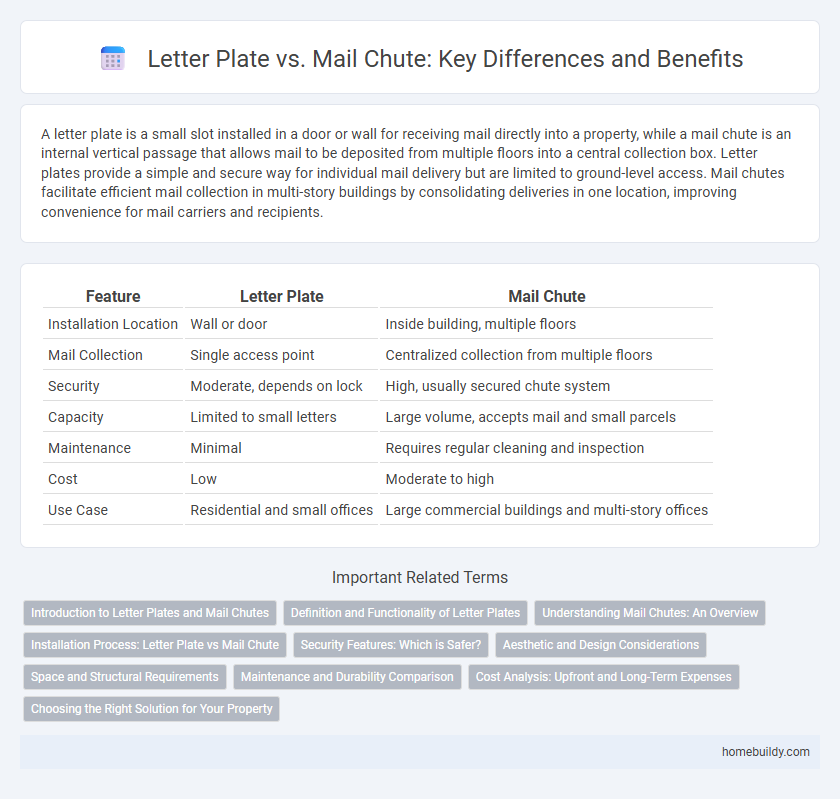A letter plate is a small slot installed in a door or wall for receiving mail directly into a property, while a mail chute is an internal vertical passage that allows mail to be deposited from multiple floors into a central collection box. Letter plates provide a simple and secure way for individual mail delivery but are limited to ground-level access. Mail chutes facilitate efficient mail collection in multi-story buildings by consolidating deliveries in one location, improving convenience for mail carriers and recipients.
Table of Comparison
| Feature | Letter Plate | Mail Chute |
|---|---|---|
| Installation Location | Wall or door | Inside building, multiple floors |
| Mail Collection | Single access point | Centralized collection from multiple floors |
| Security | Moderate, depends on lock | High, usually secured chute system |
| Capacity | Limited to small letters | Large volume, accepts mail and small parcels |
| Maintenance | Minimal | Requires regular cleaning and inspection |
| Cost | Low | Moderate to high |
| Use Case | Residential and small offices | Large commercial buildings and multi-story offices |
Introduction to Letter Plates and Mail Chutes
Letter plates are wall-mounted openings designed to securely receive letters directly into a building, featuring a flap or slot to protect against weather and unauthorized access. Mail chutes are vertical shafts installed inside multi-story buildings, allowing mail to be dropped from upper floors into a central collection box on the ground floor. Both systems enhance mail handling efficiency, with letter plates suited for single-entry use and mail chutes optimizing centralized mail collection in high-rise structures.
Definition and Functionality of Letter Plates
Letter plates, also known as letterboxes or mail slots, are fixed openings typically installed on doors or walls to receive mail directly into a building. Unlike mail chutes, which are vertical shafts allowing mail to be dropped from upper floors to a secure collection point below, letter plates provide immediate access to incoming letters without the need for additional infrastructure. Their primary function is to facilitate convenient, secure delivery of correspondence while maintaining building security and weather protection.
Understanding Mail Chutes: An Overview
Mail chutes are vertical mail delivery systems installed within buildings, allowing tenants to drop mail into a centralized collection point without leaving their floor. Unlike letter plates, which are typically small openings on doors or walls for direct mail insertion, mail chutes streamline mail collection by funneling letters from multiple floors to a secured mailbox or mailroom. These systems improve building mail handling efficiency and reduce the risk of misplaced correspondence.
Installation Process: Letter Plate vs Mail Chute
Letter plate installation involves cutting a precise opening in the door or wall to fit the plate securely, often requiring minimal structural alteration and basic tools for mounting. Mail chute installation necessitates creating a vertical shaft through multiple building floors, demanding extensive structural modifications, professional expertise, and permits due to its complexity and fire safety considerations. While letter plates are straightforward and cost-effective to install, mail chutes require significant planning and construction resources, impacting overall project timelines and budgets.
Security Features: Which is Safer?
Letter plates offer enhanced security with their simple, solid design that minimizes unauthorized access and tampering compared to mail chutes, which can be more vulnerable due to their larger openings and internal access points. Mail chutes often require regular maintenance to prevent jamming and unauthorized retrieval, while letter plates have fewer mechanical parts, reducing potential security risks. The durable construction and ease of installation of letter plates provide a highly secure option for residential mail delivery.
Aesthetic and Design Considerations
Letter plates offer a sleek, minimalistic design that integrates seamlessly with modern doors, enhancing curb appeal and maintaining exterior aesthetics. Mail chutes, on the other hand, often require bulkier installations inside buildings, potentially disrupting interior design flow and space utilization. The choice between a letter plate and a mail chute hinges on prioritizing unobtrusive appearance versus centralized mail collection functionality.
Space and Structural Requirements
Letter plates require minimal space and can be installed directly on doors or walls without the need for additional structural support, making them ideal for compact or retrofit applications. Mail chutes demand more extensive vertical space spanning multiple floors and require robust structural integration to accommodate the chute mechanism and mail collection units. Choosing between the two depends on building design constraints and available installation space, with letter plates offering greater flexibility in limited or non-commercial settings.
Maintenance and Durability Comparison
Letter plates require minimal maintenance, primarily periodic cleaning and occasional hinge lubrication, ensuring long-lasting durability due to their simple mechanical design. Mail chutes involve more complex components like chutes, traps, and collection boxes, necessitating regular inspections and repairs to prevent jams and wear, making their maintenance more intensive. In terms of durability, letter plates generally outperform mail chutes as they are less prone to mechanical failure and environmental damage.
Cost Analysis: Upfront and Long-Term Expenses
Letter plates generally have lower upfront installation costs compared to mail chutes, which require extensive construction and maintenance. Over time, letter plates incur minimal expenses, limited to occasional repairs or replacements, whereas mail chutes demand ongoing maintenance and cleaning, increasing long-term costs. This cost disparity makes letter plates a more budget-friendly choice for residential and low-traffic commercial buildings.
Choosing the Right Solution for Your Property
Letter plates offer a secure and weather-resistant entry point for individual mail delivery directly into each unit, making them ideal for homes and low-rise buildings requiring minimal maintenance. Mail chutes provide a centralized system suitable for high-rise or multi-floor buildings, streamlining mail collection but often necessitating regular cleaning and maintenance to prevent blockages. Selecting between letter plates and mail chutes depends on building height, resident convenience, security needs, and long-term upkeep considerations.
letter plate vs mail chute Infographic

 homebuildy.com
homebuildy.com